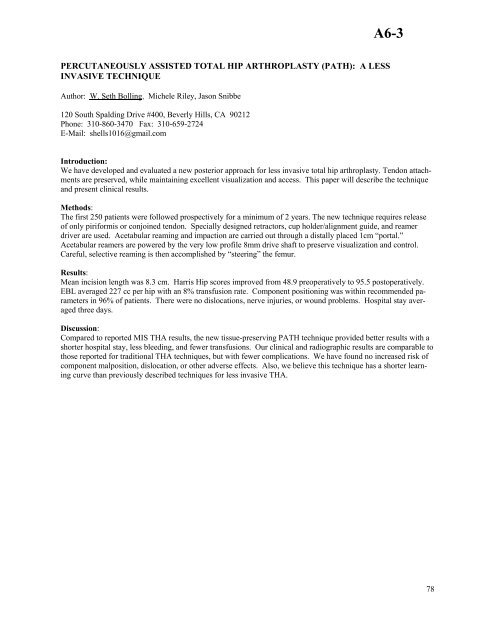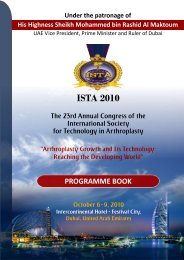ista 2007 program at a glance
ista 2007 program at a glance
ista 2007 program at a glance
You also want an ePaper? Increase the reach of your titles
YUMPU automatically turns print PDFs into web optimized ePapers that Google loves.
A6-3<br />
PERCUTANEOUSLY ASSISTED TOTAL HIP ARTHROPLASTY (PATH): A LESS<br />
INVASIVE TECHNIQUE<br />
Author: W. Seth Bolling, Michele Riley, Jason Snibbe<br />
120 South Spalding Drive #400, Beverly Hills, CA 90212<br />
Phone: 310-860-3470 Fax: 310-659-2724<br />
E-Mail: shells1016@gmail.com<br />
Introduction:<br />
We have developed and evalu<strong>at</strong>ed a new posterior approach for less invasive total hip arthroplasty. Tendon <strong>at</strong>tachments<br />
are preserved, while maintaining excellent visualiz<strong>at</strong>ion and access. This paper will describe the technique<br />
and present clinical results.<br />
Methods:<br />
The first 250 p<strong>at</strong>ients were followed prospectively for a minimum of 2 years. The new technique requires release<br />
of only piriformis or conjoined tendon. Specially designed retractors, cup holder/alignment guide, and reamer<br />
driver are used. Acetabular reaming and impaction are carried out through a d<strong>ista</strong>lly placed 1cm “portal.”<br />
Acetabular reamers are powered by the very low profile 8mm drive shaft to preserve visualiz<strong>at</strong>ion and control.<br />
Careful, selective reaming is then accomplished by “steering” the femur.<br />
Results:<br />
Mean incision length was 8.3 cm. Harris Hip scores improved from 48.9 preoper<strong>at</strong>ively to 95.5 postoper<strong>at</strong>ively.<br />
EBL averaged 227 cc per hip with an 8% transfusion r<strong>at</strong>e. Component positioning was within recommended parameters<br />
in 96% of p<strong>at</strong>ients. There were no disloc<strong>at</strong>ions, nerve injuries, or wound problems. Hospital stay averaged<br />
three days.<br />
Discussion:<br />
Compared to reported MIS THA results, the new tissue-preserving PATH technique provided better results with a<br />
shorter hospital stay, less bleeding, and fewer transfusions. Our clinical and radiographic results are comparable to<br />
those reported for traditional THA techniques, but with fewer complic<strong>at</strong>ions. We have found no increased risk of<br />
component malposition, disloc<strong>at</strong>ion, or other adverse effects. Also, we believe this technique has a shorter learning<br />
curve than previously described techniques for less invasive THA.<br />
78
















